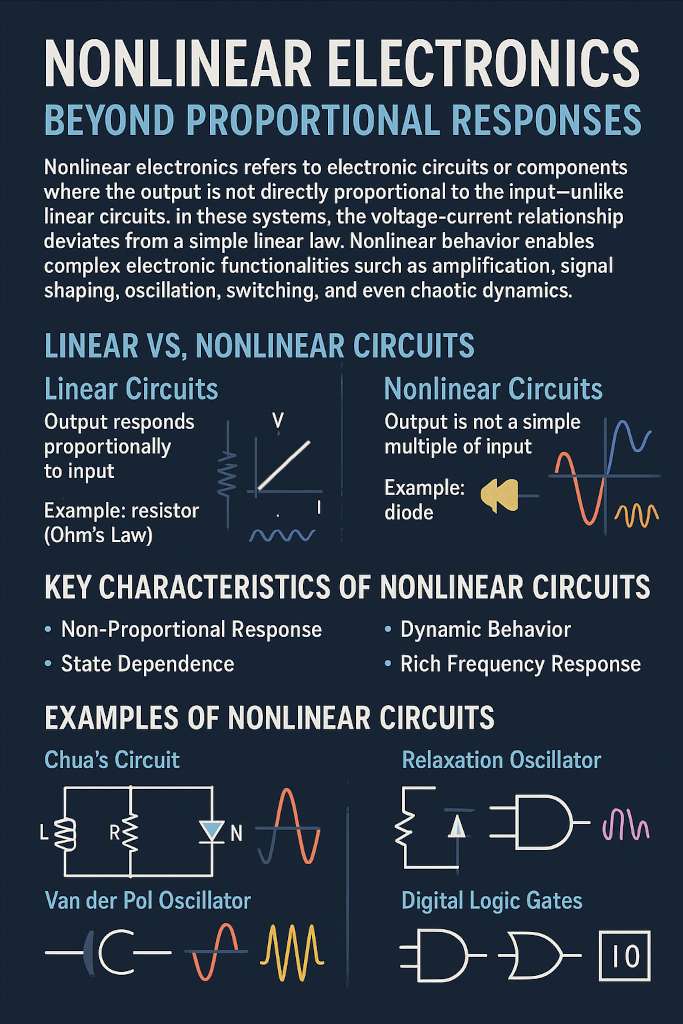Nonlinear electronics refers to electronic circuits or components where the output is not directly proportional to the input—unlike linear circuits. In these systems, the voltage-current relationship deviates from a simple linear law. Nonlinear behavior enables complex electronic functionalities such as amplification, signal shaping, oscillation, switching, and even chaotic dynamics.

Linear vs. Nonlinear Circuits
Linear Circuits
In a linear circuit, the output responds proportionally to the input. For instance, doubling the input voltage typically doubles the output. A classic example is a resistor obeying Ohm’s Law (V = IR), assuming a constant resistance.
Nonlinear Circuits
Nonlinear circuits exhibit non-proportional relationships between input and output. Doubling the input might lead to a disproportionately large or small output—or even oscillatory or chaotic behavior. These circuits often involve elements that violate Ohm’s Law or introduce feedback, thresholds, or memory effects.
Key Characteristics of Nonlinear Circuits
- Non-Proportional Response: Output is not a simple multiple of input.
- Dynamic Behavior: Can exhibit oscillations, bifurcations, or chaos.
- State Dependence: Output may depend on past inputs (i.e., memory effects).
- Rich Frequency Response: They can generate or manipulate harmonics and intermodulation products.
Examples of Nonlinear Components
- Diodes – Conduct in one direction, with exponential I-V curves.
- Transistors – Exhibit current amplification and nonlinear switching behavior.
- Varistors, Saturable Inductors, and Tunnel Diodes – Nonlinear voltage-current characteristics.
- Nonlinear Capacitors (e.g., varactors) – Capacitance depends on voltage.
Examples of Nonlinear Circuits
- Chua’s Circuit
A classic example of a nonlinear dynamical system, known for exhibiting chaotic behavior. It includes nonlinear resistors (Chua’s diode) and inductive-capacitive feedback to create complex oscillations. - Van der Pol Oscillator
A nonlinear LC circuit with a negative-resistance element, capable of self-sustained oscillations—widely studied in nonlinear dynamics and electronics. - Relaxation Oscillators
Use nonlinear elements like Schmitt triggers or unijunction transistors to produce abrupt transitions and periodic signals. - Digital Logic Gates
Operate in nonlinear regimes to realize switching behavior and binary operations. - Mixers and Frequency Multipliers
Use nonlinearities to combine or multiply signal frequencies in RF systems.
Applications of Nonlinear Electronics
- Signal Processing: Nonlinearities enable rectification, clipping, modulation, and harmonic generation.
- Switching and Control: Essential in transistors, logic circuits, and digital systems.
- Oscillators and Signal Generators: Nonlinear feedback creates stable or chaotic periodic signals.
- Secure Communication: Chaos-based modulation (e.g., using Chua’s circuits) enables encryption and masking.
- Analog-to-Digital Conversion: Nonlinear quantization steps allow signal discretization.
Why Nonlinear Circuits Matter
Linear circuits are easy to analyze and design, but nonlinear circuits unlock a much broader range of functionalities, including behaviors impossible to achieve with linear systems alone. From memory effects in neuromorphic devices to chaotic circuits for random number generation, nonlinear electronics form the foundation of advanced analog and mixed-signal design.
In summary, nonlinear electronics encompass a vast field that includes both traditional nonlinear components and complex dynamical circuits like Chua’s circuit, offering a gateway to modern technologies in secure communications, artificial intelligence hardware, and advanced signal processing.
